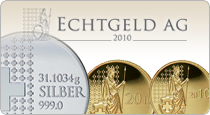
Switzerland and the monetary crisis in Europe
Author: Prof. Antal E. Fekete
Clearing house at the medieval fairs
The bill market is the clearing house, as it were, of the gold standard. It would be unthinkable to finance the journey of all goods from the producer to the consumer purely with gold coins. The so-called 100 percent gold standard is a fantasy. Gold is simply not available in sufficient quantity to allow all payments in the economy to be made in gold. Even if it were possible to do that, it would make the gold standard a fetter on technological progress. Any advance in the division of labor would unduly squeeze the money supply.
A useful comparison can be made with the great medieval fairs, such as those of Barcelona, Lyon, Leipzig, and others where the gold coin was not the medium of exchange. A variant of the real bill, the scrip was. All buying and selling at the fair were performed by scrip, eliminating the need for gold coins. Scrip received by the sellers could be spent in buying any good offered at the fair. At the close of the fair, scrip representing the difference between goods sold and goods purchased was settled in gold coin at the clearing house. It would not have been possible to organize fairs without such a clearing system, to a great loss in trading opportunities.
Why Britain’s 1925 return to the gold standard was doomed
The outbreak of World War I stamped out the bill market and the international circulation of real bills as production for civilian uses was subordinated to the war effort. After the armistice in 1918, real bills were not allowed to make a comeback for political reasons. The ban on the international circulation of real bills was maintained even after 1925, when Britain returned to the gold standard. The victorious Entente powers preferred bilateral to multilateral trade for fear of German competition. They failed to see that the international gold standard was not viable without its vital organ, the clearing house, that is, the international bill market. They also failed to see that bilateral trade requires a far larger gold reserve than multilateral trade, which they did not have. As a consequence, Britain’s gold standard was deflationary and was doomed.
The crisis started in 1931 with Britain going off gold; it continued in 1933 with America following suit. In 1936, France and Switzerland, the last bastions of the gold standard, surrendered. The collapse was blamed on the gold standard itself that was declared ‘deflation-prone’. The truth is that not the gold standard was deflation-prone, but the system of bilateral trade that the British tried to bring back. The bilateral system of trade compares to the multilateral as the wheelbarrow compares to the cargo jet plane. Bilateral trade is barter. This point was completely missed by the economists in the Anglo-Saxon countries. By contrast, the German economist Heinrich Rittershausen (1898-1984) had a much better grasp on appreciating-real bills financing of world trade. He predicted the Great Depression in 1929.




